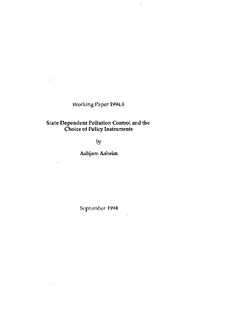| dc.contributor.author | Aaheim, H. Asbjørn | nb_NO |
| dc.date.accessioned | 2014-03-17T14:31:11Z | |
| dc.date.available | 2014-03-17T14:31:11Z | |
| dc.date.issued | 1994 | nb_NO |
| dc.identifier.issn | 0504-452X | nb_NO |
| dc.identifier.uri | http://hdl.handle.net/11250/192216 | |
| dc.description.abstract | The paper examines the role of policy instruments aiming at the control of environmental problems. If there is a complex relationship between economic activities and environmental effects, the use of indirect economic measures such as environmental taxes may be inefficient compared with direct abatement measures. Moreover, an optimal tax can not be assessed if the level of abatement efforts is sub-optimal. This calls for an integrated approach to the analysis of environmental policy, including cost-benefit analysis of abatement measures. It is shown that cost-benefit evaluations of abatement should include a shadow price on environmental qualities that is likely to increase over time. The effect of this increase may outweigh the effect of discounting, thus making environmental benefits of present abatement measures in the far future count even with a high discount rate. | nb_NO |
| dc.language.iso | eng | nb_NO |
| dc.publisher | CICERO Center for International Climate and Environmental Research - Oslo | nb_NO |
| dc.relation.ispartof | CICERO Working Paper | nb_NO |
| dc.relation.ispartofseries | CICERO Working Paper;1994:08 | nb_NO |
| dc.title | State dependent pollution control and the choice of policy instruments | nb_NO |
| dc.type | Working paper | nb_NO |
| dc.source.pagenumber | | nb_NO |
